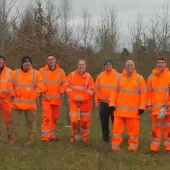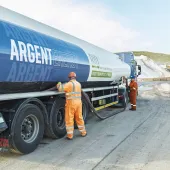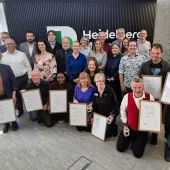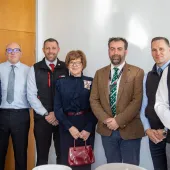First phase of tree planting completed at Bradley

Banks Mining complete initial phase of planting as plans for new community wildlife area progress
THOUSANDS of new saplings are beginning to take root in the new community wildlife area being created as part of the operations of the Bradley surface mine, in Co. Durham, after Banks Mining completed the first phase of tree planting at the site.
Around 3,500 trees, including oak, birch, rowan, bird cherry, alder, holly, hawthorn, hazel and crab apple, have been planted on an initial 3.2ha of land in the north-west corner of the site as part of Banks’ progressive landscaping work at Bradley.
The new trees are between 40cm and 60cm tall, which is the optimum size at which they can become established in the soil and grow quickly, and the species have been chosen to replicate the area’s existing woodland mix.
The edge of the new woodland has also been shaped in a ‘scalloped’ fashion, which will maximize the most diverse ‘edge’ habitat and help to provide a varied structure for different insects, birds and mammals, thus encouraging local biodiversity.
Around 10,500 trees in total will be planted at the Bradley surface coal mine during the creation of the new wildlife reserve, which is due to be completed by August 2021.
Banks Mining have planted more than 1.2 million trees across the 113 surface mine sites they have restored across Scotland and northern England over the last four decades.
As well as a mixture of a new woodlands, the final landscaping of the Bradley site will contain a diverse range of ecological habitats including wildflower grassland, species-rich hedgerows with hedgerow trees, ponds and footpaths alongside agricultural land.
Mark Simmons (pictured), landscape architect at Banks Mining, said: ‘Tree planting is an essential part of all our surface mine landscaping schemes. Trees give structure and pattern to the landscape and can be designed with different structures and species to provide a great diversity of wildlife habitats along with valuable recreational spaces.
‘Scalloping the edges of the woodland, rather than having a sharply defined boundary, creates a series of graduated zones between the trees and the neighbouring open area, with different species of wildlife able to make use of different parts of this edge habitat.
‘This new tree and shrub planting is the first part of landscaping works for the creation of the new wildlife area at Bradley. The trees can be establishing now so they’re more mature by the time the main site is progressively landscaped as our operations progress, and we’ll be planting thousands more trees as work on site progresses.’









